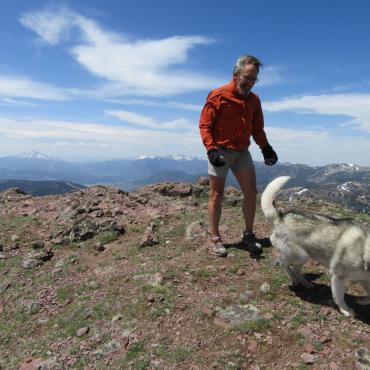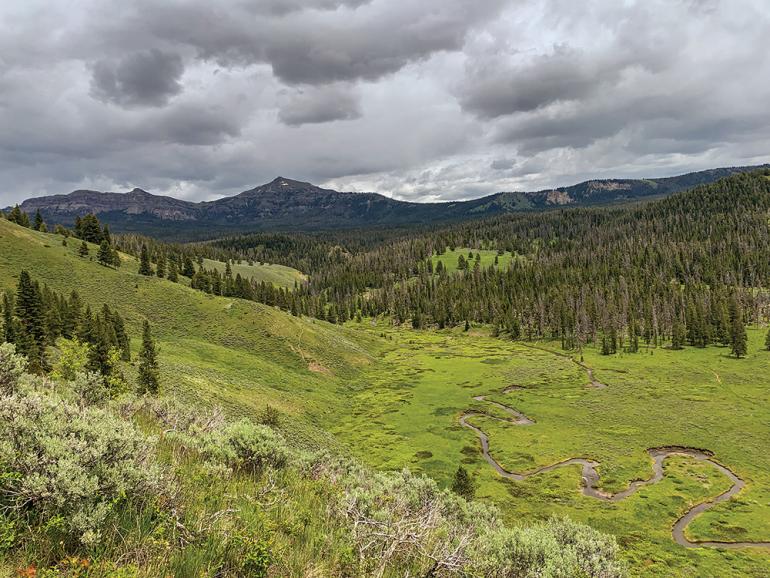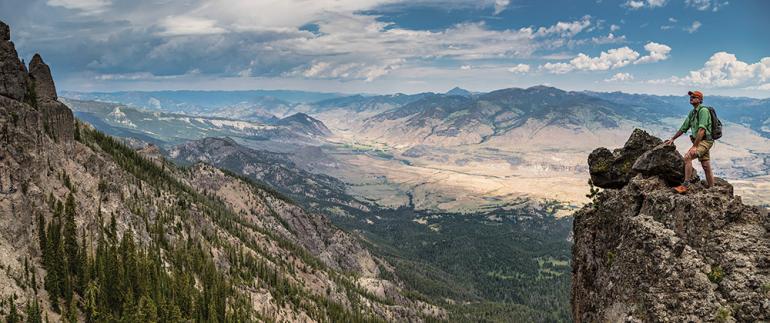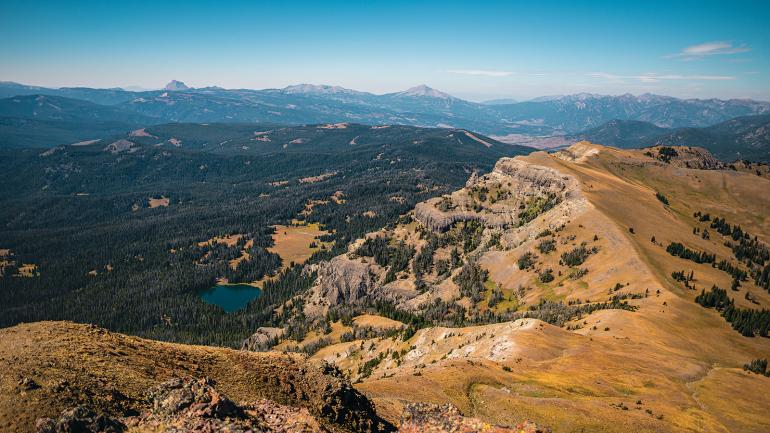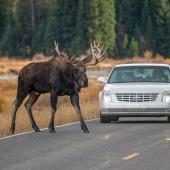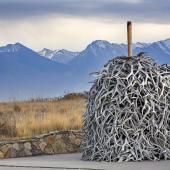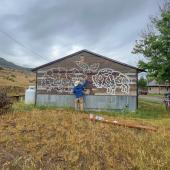The Inherent Trauma of Conservation
In order to save the Greater Yellowstone Ecosystem and its true wilderness character, there must be a fundamental shift—in how we think and feel about nature.
As the combination of human overpopulation and our uncritically consumerist civilization increasingly threatens to push Earth’s rich biodiversity past the brink, a chapter in the ecological and aesthetic history of our planet is being written right now in the Greater Yellowstone Ecosystem (GYE). The conclusion of that chapter, yet to be penned, will make a huge difference in what sort of place this will become.
Within the environmental community, there are grave differences of opinion about the path forward, about what is realistic, and what should be accepted as practical. The future management of the Custer-Gallatin National Forest is on the table, with a final Forest Plan imminent. Perhaps its most crucial element concerns the adjoining Porcupine and Buffalo Horn Creek drainages. Situated a stone’s throw from Big Sky, these watersheds are the most wildlife- and ecosystem-crucial portion of the Hyalite–Porcupine–Buffalo Horn Wilderness Study Area. They also comprise the most important wildlife corridor between the GYE and its connectivity-dependent Northern Continental Divide Ecosystem to the west and north.
What’s going to determine the outcome is one of two visions—two different approaches to our relationship with nature. The question is, which will prevail?
Competing Visions
Do we want to be able to ride our mountain bikes and motorized toys from our hotel-room doors right to the trailheads, ride all up and down these adjacent lush, lower-elevation drainages, whose gentle slopes with mixed forest and meadowlands house a major Yellowstone elk herd in its birthing and wintering? Expanses that are crucial to the Yellowstone grizzly’s survival? Landscapes that provide a rich home to the majestic and hauntingly social grey wolf? Do we ride there, and displace these icons and domesticate this wild hermitage, making it but one more city park, one more recreation playground amongst so many spread throughout the West?
Imagine instead that we make the Porcupine and Buffalo Horn trailheads two boundary and entry points of a Gallatin Yellowstone Wilderness. Instead of capitulating to the oft-cited claim that “It’s already prized as a wonderful mechanized and motorized recreation area,” we take very different advantage of its proximity to Big Sky. Imagine visitors and residents awed and humbled by a magnificent Wilderness cathedral gazed upon from their homes, their hotel rooms, the decks of their favorite bistros and breweries. They would find quietude right there on the edge, where a privileged bastion of civilization butts up against what is still our Last Best Place. Rather than bemoan the unenforceability of the Wilderness boundary, the Forest Service would acclaim its spontaneously honored edge, as tired and questing souls would be invigorated by, and deeply protective of, the wild beauty and natural splendor that we had the maturity to preserve.
Necessary Shifts
Here’s the rub. A transformation of our individual and collective psyches will be necessary to achieve such a vision. Promoted by our pervasive capitalist discourse, constant and immediate satisfaction has come to be misunderstood as the measure of a good life. Whereas culture’s prevailing moral injunction and measure of self-worth used to be “Avoid forbidden pleasures,” today it’s “Enjoy!” If you aren’t enjoying, there is something wrong with you. Although ultimately unfulfilling, self-gratification is compulsively sought after.
Pushing into more and more relatively pristine wild lands, for the sake of our various gratifications that here especially include recreational ones, is my focus. Recreation—mechanized and motorized recreation—affords a means to fulfill the societal command to Enjoy!
To set limits, to not push further into pristine lands, requires us leaving behind this empty but alluring Sirens’ call.
A middle-schooler patient of mine often spoke of her struggle with what she called boredom. She didn’t yet realize that boredom was her misrecognition of ordinary or universal existential angst, and the difficulty to exist quietly with it, in our own skins, in our own minds. She was at the doorstep of the human quest, to find meaning greater than ourselves through the transformation of a foundational anxiety that contemporary society nonetheless censors. She noted that she found it almost unbearable to sit still with, and be reflective about, her inner experience at such moments. She didn’t then have the language to know that she was encountering the inherent trauma of being human.
"A transformation of our individual and collective psyches will be necessary to achieve such a vision."
It is a sense of disruptive unquenchability that will arise in us over and over. To notice it, though, we must have the wherewithal not to flee from it, the integrity and courage to hold it, rather than self-deceptively seek some illusion of filling its void. Yeah, void. A word that psychoanalysts use to name the fact that there is only an emptiness at that place where we might compulsively look for excitement or admiration—anything to conceal what those in my field also refer to as lack. That is, a loss without an actual identifiable thing itself having been lost. A lacking of a nonexistent thing that we falsely believe we can find and that will make us feel full again.
Its transformation is what psychoanalysis has, since Freud, called sublimation: when we slow down and aren’t engaged in, or daydreaming about, some preoccupying and instinct-satisfying activity, thus taking on this strange and roiling stillness within us. Whether we can turn that into quietude—a place of inner peace for the inherent trauma of being human—is another matter altogether.
We either distract ourselves with some maniacal or hyperactive preoccupation, maybe even pretending that we are in a state of quietude, or we evolve. I once saw a documentary of an outdoor adventure, in which the lone backcountry traveler narrated his challenging physical experience. In a way, it was awesome. But the funny thing about it was that, actually, he was on stage for the world, through his staging and filming, and speaking to his future, imagined viewer. One long selfie.
Creating a New Way
There have been some excellent essays written lately about how southwest Montana needs a new narrative of its relation to nature. They are exhortations calling for self-restraint, and societal restraint in our tendency to capitalize on wild places for the sake of our enjoyments—exhortations to move away from a consumerist or dominant relationship. From “Hey, you rocked, riding all the way in and out of that drainage today!” and “Yeah, you ate it up!” to instead moving toward a quiet ecological and aesthetic sensibility that foregoes our egoistic urges, or wishes for demonstrable accomplishment and showy physical fitness, and toward a conservation aesthetic, as Aldo Leopold put it, that deeply and humbly moves us, based solely on protecting wild areas that are bigger than us, where we are not only mere visitors but also at the mercy of the wildness of the place.
“Giving up our toys is part and parcel of growing up and giving up our illusions.”
When we don’t have machines of any sort facilitating and hastening our penetration deep into wild places, they can remain wild. Then there is little human activity, and only our quiet and slow-moving presence, deep in the wild. Then, the grizzly, the wolf, the huge elk herd, the wolverine can survive. And we can encounter the sublime.
This would be our navigation of the inherent trauma of conservation.
Radically accepting limits and restraint, harnessing the drive for satisfaction, and finding a meaningful and rich life therein, that is the human quest. It is our derailings of this quest that causes individual psychopathology, the destructivity of civilization, and our destruction of the planet’s biomes.
On the one hand, we owe a lot to Montana’s “Big Greens”—in this case, Montana Wilderness Association, Greater Yellowstone Coalition, and the Wilderness Society. I myself was president of Montana Wilderness Association from 2006-2008, and feel honored to have served in that capacity. But in partnering with recreation groups to recommend the ceding of the Porcupine and Buffalo Horn drainages to mountain biking, snowmobiling, and motorcycling, they have been caught in this very lure of the Enjoy! mandate. It’s an acceptance not to notice the profound ecological and aesthetic consequences of their acquiescence. They have been caught in the illusion of filling the void.
A Transformative Leadership Paradigm
There is a finely crafted piece of videography produced by these Big Greens. The film promotes the Wilderness abolition of the Porcupine and Buffalo Horn drainages. That’s right! I know it is hard to believe. At Gallatin Valley Earth Day this April 17 and April 24, many people were surprised to learn of this. Some were shocked. One in particular was shaken by a sense of betrayal that she could not assimilate, as it did not match up with her understanding of her Montana Wilderness Association.
The film in question shows young and vibrant recreationists launching themselves into nature. It’s as though all is well, and we don’t have to think about the motorized and mechanized mecca that will soon establish itself across the Gallatin River from Big Sky, as if the Big Greens are not recommending this.
Here in southwest Montana, where I have planted my flag, transformative leadership can rise up, perhaps must rise up, to promote and practice a new vision, one of an eco-psychological way of being, one that would halt the continuous shrinking of the Last Best Place.
"They have been caught in the illusion of filling the void."
If the Big Greens used all their ample funding and staff resources to mobilize or awaken a groundswell of vocal Wilderness support from the people, it seems a practical aim. But they would have to give up promoting Wilderness as an opportunity for one more selfie, and esteem it for the empyreal place that it is: a place to sublimate our baser enjoyments and their urgencies, and to engage with something greater than ourselves.
However, when we are caught in a collective lure that the excitement and adventure of our prowess can eradicate the void or the lack, we have no foundation from which to practice individual and societal restraint. We are then identified with a group image that blocks our access to tranquility and quietude. We are then captive to the Enjoy! injunction at the expense of nature. We are left jonesing for our next fix.
The Path Forward
The Big Greens must join forces with grassroots groups to practice an inextricable relationship between environmental ethics and human maturational development. They would then be speaking up for the need for a higher form of meaning and happiness than the popular ones. They would be speaking up for the fulfillment of the human quest, mankind’s search for meaning, and its reliance upon a deep respect for nature that has been lost to shallowness.
A young woman I know told me, regarding the idea that we must set transformative limits on society’s addiction to recreation, “I know! But I don’t want to give up my toys!”
Yep. That about says it. Giving up our toys is part and parcel of growing up and giving up our illusions. But maturing is a journey without fanfare, and is not conducive to popularity and proms and pompoms. It is not flashy, or loud, or photographable. It doesn’t flex its muscles in the mirror.
I remember well when an esteemed psychoanalyst proposed to me that although I was a practicing clinician, I had not finished traversing adolescence—had not grown up into adulthood. I was incensed and indignant. It took me some time to realize that he was right, and then even more time to move on with the quiet and unglamorous work that is then incumbent upon us.
This is what we must all do. Embrace the inherent trauma of being human, in order to animate its close cousin, the inherent trauma of conservation. Or else the Greater Yellowstone Ecosystem will pay the price—and so will we, once we realize what we’ve done.
Joseph Scalia III, Psya.D. is a psychoanalyst in private practice in Livingston. He is the president of the Gallatin Yellowstone Wilderness Alliance, and a past president of the Montana Wilderness Association.

